How Much Does It Cost To Build A Logistics App in 2024
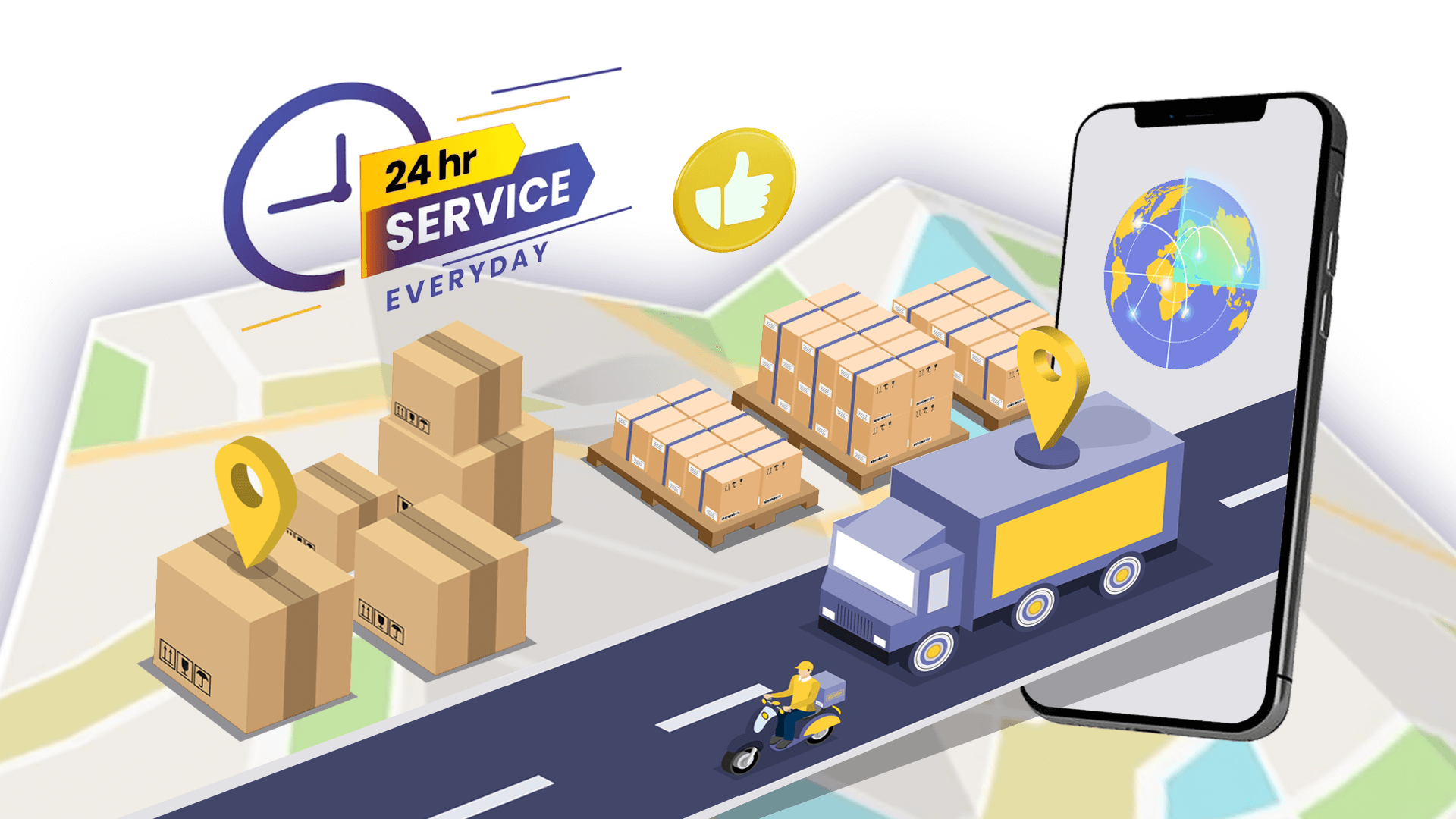
The logistics market is on the rise, projected to grow USD 125.65 billion from 2022 to 2027, with a creditable CAGR of 2.12%. This growth, described in detail using a broad market analysis as presented above, shows the importance of logistics app development. Today, the modern world where everything is moving at a very high pace and speed could hardly be called anything but an efficiency. The demand for advanced logistics has never been so great than what it is in this day and age.
Hence, both businesses and individuals have started to perceive how important logistics apps are in the highly comprehensive dynamics involved with supply chain management. The advantages, though, are impressive – from good warehouse and fleet management to real-time vehicle tracking. The attractions are in terms of lowering cost, efficiency and quick return from investment on the issue.
Picture a situation in which logistics within the warehouses are planned accordingly, routes for the vehicles have been perfectly planned and paperwork is only stored in notebooks. Companies currently offer logistics apps along the lines described above featuring seamless integration, data analytics, and actionable information. Here is a further discussion of the details concerning logistics app functionality, causes for demand or poor results, terms of solutions with associated cases, and crucial features that target consumers trusting drivers and dispatchers.
With this, welcome to the ride of tech stack and integration intricacies, revealing step-by-step patterns on how development works as a logistics app. We have that for you in the form of a thorough anatomy. Once all these are done after this clear understanding, you can now start your journey towards a successful logistics app development.
How Does a Logistics App Work?
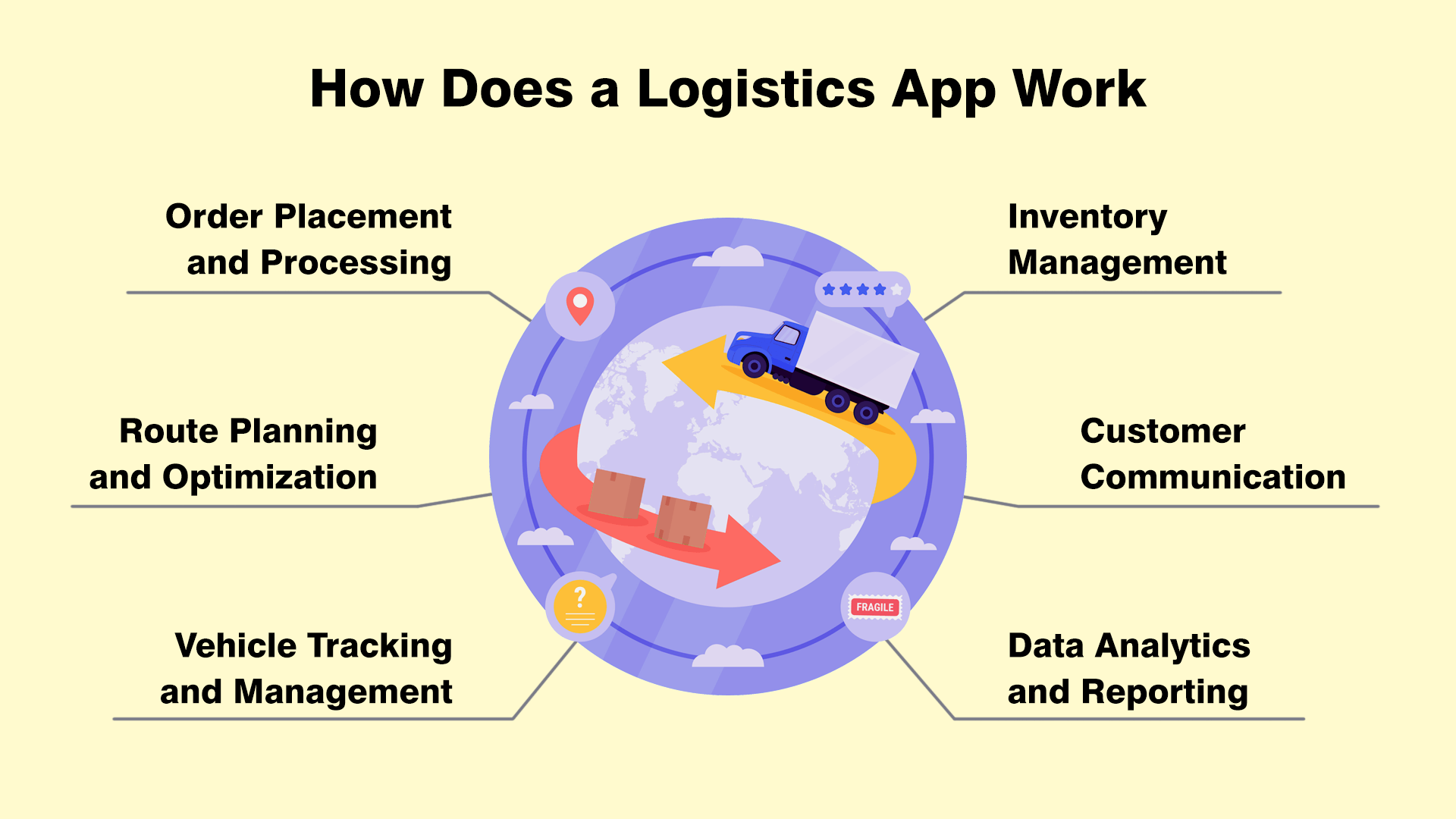
Just like choreographed dance in the dynamic world of logistics, the smooth functioning of a logistics app is likened to conducting and synchronizing moves for a well-rehearsed dance. Let’s unlock the basic inner mechanisms, critical functions, and methodologies that speak all these apps are at the base of effective supply chain management.
Order Placement and Processing
- How It Works: The app is later used by users to place the orders which are then responsible for initiating the logistics process.
- Key Functionality: The app validates and processes orders to ensure all the details that include accuracy, set name of company, name of the product and quantity are calculated before placing an order on a webpage.
Route Planning and Optimization
- How It Works: The app reviews the location and determines the best way of navigation for delivery.
- Key Functionality: Live rerouting factor is through various adjustments in a real-time manner by understanding the condition of traffic, weather, and other factors.
Vehicle Tracking and Management
- How It Works: Via GPS it is possible to track the movement of vehicles in a constant way as it happens in real time.
- Key Functionality: Fleet managers could track vehicle and track location, speed and condition.
Inventory Management
- How It Works: This application runs through in-warehouse or fleets to assist it to track and control the inventory levels.
- Key Functionality: The real-time updates to the stock levels are also responsible for understanding demand predictions.
Customer Communication
- How It Works: The customer ‘s status for the order is automatically communicated and updated by means of notification to customers.
- Key Functionality: Makes customer experience better to be more transparent and communicative.
Data Analytics and Reporting
- How It Works: Information is drawn from the app, which informs decision making.
- Key Functionality: It enables businesses to make right choices in their process optimization activities.
Examples and Use Cases
Uber Freight
- How It Works: It simplifies the connections between the shippers and carriers by creating a creative route, which minimizes empty truck miles.
- Key Functionality: The benefits that the retailers get from price and load matching protocols include real-time pricing, load matching, and communications transparency.
Amazon Logistics
- How It Works: Dedicated to a smart logistics system that guarantees timely and efficient deliveries.
- Key Functionality: Robotics for advancement, analytics of data, and route optimization as a means to obtain optimally functioning operations.
Walmart's In-House Logistics App
- How It Works: It manages the entire supply chain plus keeping an eye on each point that includes not only inventory but also last-mile delivery.
- Key Functionality: Provides integration to suppliers, warehouses and transportations for complete end-to-end visibility.
To that effect, comprehending such core functionalities and live implementations demonstrates how logistics apps function as catalysts for the improved effectiveness and visibility of logistics. In the next section, we will discuss the widespread reasons for logistics apps breakdown and how to address them.
Why Do Logistic Apps Fail?
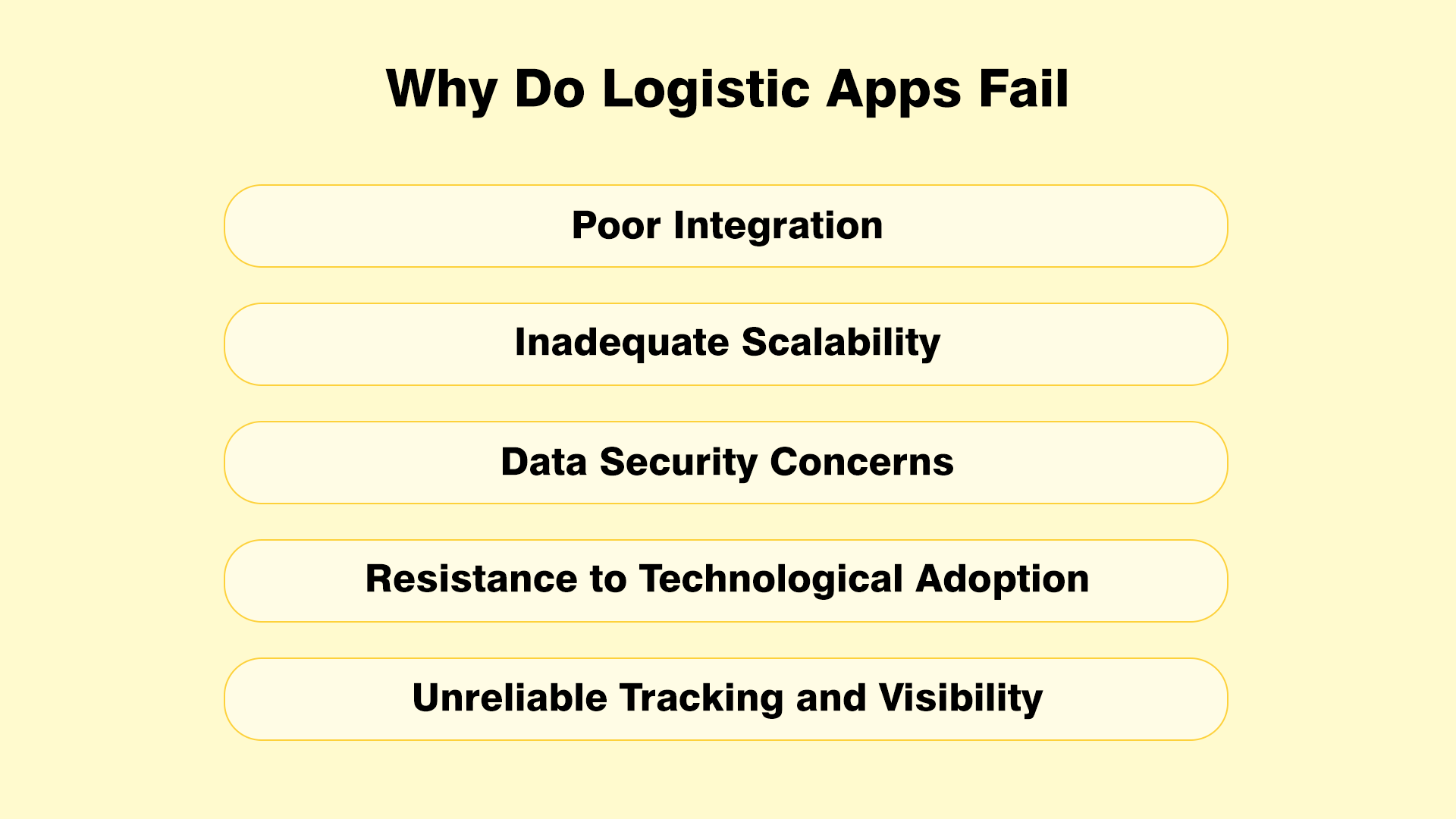
Among all these different elements found in the dynamic logistics territory, the road from app ideation until successful implementation is full of obstacles. Knowing the traps along the way that could cause these logistics applications to fail is vital for companies planning on launching successful implementations of them.
Common Challenges Faced by Logistics Apps
Poor Integration
- Challenge: Lack of appropriate system integration is likely to result in data centers and impair the flow of operations.
- Reason for Failure: There is also the absence of harmonized flow of information between various components.
Inadequate Scalability
- Challenge: To allow for growth in a system, failure to accommodate may lead to overload.
- Reason for Failure: Inability to cope with the increasing number of orders and transactions that were needed each day.
Data Security Concerns
- Challenge: Security is tight, and a hole could have catastrophic results. A leak in logistic apps threatens extremely sensitive data.
- Reason for Failure: Failure to ensure appropriate cybersecurity capabilities that might lead to data leaks or unauthorized access.
Resistance to Technological Adoption
- Challenge: Employee resistance to change or stakeholders for change dissuasion.
- Reason for Failure: Inefficiencies caused by a lack of user buy-in and training.Wasted rates due to inadequate purchase placed by the users.
Unreliable Tracking and Visibility
- Challenge: Inaccurate or late tracking of dispatches and inventory.
- Reason for Failure: Low performance in customer experience and a number of operational inefficiencies due to the lack of real-time visibility.
Reasons for Failure and Potential Pitfalls
Underestimating Development Costs
- Reason for Failure: Poor budgeting results in the compromised app quality with minimal functionality.
- Insight: Carry out a cost analysis process, estimating the development costs, maintenance fees and scalability.
Ignoring User Experience
- Reason for Failure: When the interface of a website is not friendly to its end-users, failing to consider them as the first and foremost priority it ends up attracting lower adoption rates.
- Insight: In considering the user experience, and how much easier it is applied for their use; invest in UX design to facilitate ease of use among high users satisfaction.
Inadequate Testing
- Reason for Failure: A lack of sufficient testing can create flaws and eventually cause performance errors.
- Insight: Establish critical test procedures even such as stress testing, or let alone user acceptance.
Lack of Flexibility
- Reason for Failure: Inevitably, in the change of developing industries and their customers’, inflexibility is made evident here.
- Insight: Use the app’s flexibility and future scalability in mind-related designing needs for evolves.
How to Overcome These Challenges
- Comprehensive Training Programs - Resort to intensive training programs for users and stakeholders along with a timely exercise of phase implementations.
- Regular Updates and Maintenance - Perform regular updates and maintenance to respond to security issues and remain in touch with current technology.
- Collaboration and Communication - Encouraging collaboration and free communication among developers, stakeholders, as well as end users.
- Continuous Improvement - Promote an uninterrupted improvement ethic, which responds promptly and proactively to challenges.
By being aware of those challenges and creating the motives why it failed to provide you with an opportunity, otherwise take inspiration in a strategic solution that is going to help business entrepreneurs from potential vulnerable parts. In the ensuing chapters, we will elaborate on the various categories of logistics app solutions and its real manifestation in ecommerce representing a landed use case.
Logistics App Development Solution Types & Examples
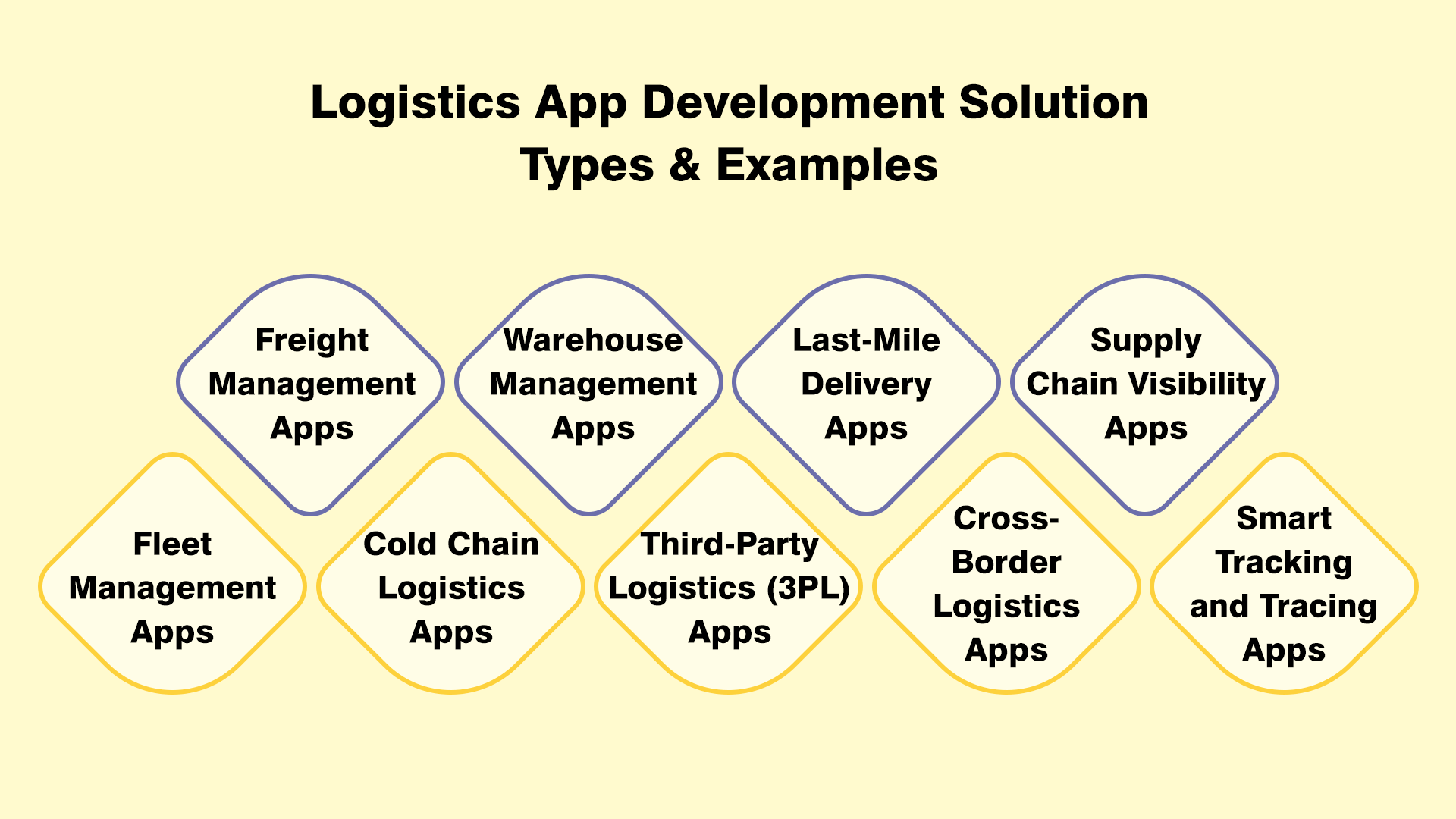
Logistics app development is a wide range of various needs within the supply chain. Now let us look at various classes of the logistics app solution with successful cases that have revolutionized efficiency and created an industry standard.
Freight Management Apps
Convoy
- Algorithm-based pairing of shippers and carriers.
- Real-time tracking and transparency of shipments.
- Efficient cost management through dynamic pricing.
Warehouse Management Apps
Fishbowl Warehouse
- Inventory tracking with barcode scanning.
- Order fulfillment automation.
- Integration with popular e-commerce platforms.
Last-Mile Delivery Apps
Postmates
- Crowdsourced delivery network.
- Real-time tracking for customers.
- Integration of local businesses for different modes of deliveries.
Supply Chain Visibility Apps
ShipChain
- End-to-end supply chain tracking through blockchain visibility.
- Smart contracts for secure and automated transactions.
- Live shipment status updates.
Fleet Management Apps
Samsara
- GPS tracking and route optimization.
- Vehicle health monitoring with diagnostics.
- Compliance management for regulatory adherence.
Cold Chain Logistics Apps
FreshTemp
- Temperature monitoring for perishable goods.
- Real-time alerts on temperature deviations.
- Cold chain regulation compliance tracking.
Third-Party Logistics (3PL) Apps
Flexport
- End-to-end logistics solutions.
- Cloud-based platform for collaboration.
- Supply chain optimization through data analytics.
Cross-Border Logistics Apps
ClearMetal
- Predictive intelligence in cross-border shipments.
- AI-enabled visibility and risk management.
- Compliance monitoring for international regulations.
Smart Tracking and Tracing Apps
FourKites
- Predictive tracking using machine learning.
- Visibility into multimodal shipments.
- Collaboration platform for stakeholders.
Such cases demonstrate the variety of logistics app solutions that are addressed to particular problems in a supply chain. Successful logistics apps have common attributes such as real-time tracking, data analytics, and seamless integration. Going forward, we will discuss the intricacies of customer-related, driver-orientated, and dispatcher features that compose a global picture of functionality that makes people successful.
Logistics App Features for Customers, Drivers, and Dispatchers
Starting a logistics trip, it is important to understand the specifics of each stakeholder- customers, drivers and dispatchers. As we move into specific characteristics tailored to each community, imagine a logistics app that not only simplifies processes but also improves all aspects of the adventure for everyone.
For Customers
- Intuitive User Interface - Suppose a logistics app that greets customers with an easy-to-use interface and offers intuitive navigation experience.
- Real-Time Shipment Tracking - Customers get to track their shipments online, giving them full transparency about the shipping of their orders.
- Automated Notifications - No more guesswork! Consider a logistics app that provides automated notifications to customers regarding order status, expected delivery date, and possible delays.
- Easy Booking and Order Management - Streamline the logistics process for customers with an app that makes reservations easy to book and orders simple to manage so as to facilitate a convenient experience.
- Customer Support Integration - Imagine a logistics app that has been integrated with customer support capabilities to help resolve queries, track tickets and provide assistance all within the same area.
For Drivers
- User-Friendly Driver Panel - Drivers are key players. Imagine an app with a driver panel that helps in easy navigation and provides required information.
- Real-Time Route Optimization - All About Efficiency. An app with real-time delivery route optimization makes sure the drivers take the shortest routes that decrease time and fuel usage.
- Instant Order Acceptance - Equip drivers with an app that enables instant order acceptance contributing to faster turnaround and improved delivery performance.
- Communication Tools - Establish good communication between drivers and dispatchers. The integration of communication tools within a logistics app would guarantee smooth coordination throughout the entire delivery process.
- Vehicle Health Monitoring - Improve road safety and avoid unexpected breakdowns by connecting a logistics app with vehicle health status features.
For Dispatchers
- Comprehensive Dashboard - Dispatchers require a single information control center for smooth functioning. Picture a logistics app that has a detailed dashboard, allowing for an overall perspective of the ongoing activities.
- Order Management System - Manage your logistics operations through a comprehensive order management system and an app that allows dispatchers to track, manage, and allocate orders efficiently.
- Automated Dispatching - Improve dispatcher efficiency using an app that can perform automated dispatch based on real-time information.
- Performance Analytics - Data-based decisions are the future. Imagine a logistics app that arms dispatchers with performance analytics, allowing them to spot trends, bottlenecks, and potential shortcomings.
- Collaboration Platform - Boost teamwork! A collaboration app that helps coordinate the activities of dispatchers, drivers and other partners enables smooth communication.
Imagine an ecosystem in which user-centric design meets great functionality when designing a logistics application for customers, drivers, and dispatchers. In sections to follow, we will delve into the tech stack, integration peculiarities and step-by-step process. Keep tuned to see your logistics vision turn into a reality.
Tech Stack & Integration for Logistics App Development
Technology stack in logistics app development is similar to selecting instruments for a well-tuned orchestra. Therefore, let’s delve into the technologies commonly used during development and discuss the importance of integration with other systems as well as factors to consider when selecting relevant ones.
Developing a logistics app should have a carefully designed technology stack involving both frontend and backend technologies.Here's an overview, presented in a tabular format for clarity:
| Component | Technology |
|---|---|
| Frontend Framework | Flutter, React Native, Swift (for iOS), Kotlin (for Android) |
| Backend Framework | Node.js, Django, Ruby on Rails |
| Database | MongoDB, MySQL, PostgreSQL |
| APIs | RESTful, GraphQL |
| Real-Time Updates | WebSockets, Push Notifications |
| Mapping and Routing | Google Maps API, Mapbox |
| Cloud Services | AWS, Google Cloud Platform (GCP), Azure |
| Security | HTTPS, OAuth, JWT |
Importance of Seamless Integration
- Enhanced Efficiency - Because the system can integrate with other systems such as ERP or CRM software, operations are streamlined which minimizes manual input and reduces errors.
- Real-Time Data Exchange - The integrated process ensures real time exchange of data between the logistics app and external systems that improves visibility and decision making.
- Holistic Visibility - Integration with tracking systems, inventory management and order processing platforms offers dispatchers as well as the customers a holistic view of the logistics chain.
- Improved Customer Experience - Integrating with e-commerce platforms or order processing systems means a smooth cruise from placing an order to receiving it.
- Optimized Resource Allocation - Integration with fleet management tools ensures that resources are allocated effectively as trucks and drivers are deployed optimally.
Choosing the Right Technologies for Robust Performance
- Scalability - Choose technologies with built-in scalability to handle increasing amounts of data and traffic. AWS or GCP cloud services offer scaling choices.
- Cross-Platform Compatibility - Go for a frontend framework such as React Native or Flutter to achieve cross-platform compatibility, and this ensures a uniform user experience over various devices.
- Real-Time Communication - Use technologies like WebSocket for synchronous communication between the app and back-end which is necessary to support features such as real time tracking updates.
- Security Measures - Enhance security by implementing HTTPS to encrypt data, OAuth for secure user authentication and JWT token-based authorization.
- Database Choice - Select a database that fits the app’s needs. MongoDB works well with flexible data structures whereas MySQL or PostgreSQL may be a better option for structured data.
- Mapping and Navigation - Varying on mapping needs, choose mapping APIs such as Google Maps API or Mapbox for precise location specific functionalities.
The proper choice of technologies while developing a logistics app not only leads to sophisticated performance but also helps the app work well within the general digital environment. The following section will reveal the logistics app development process’s step-by-step journey, turning your vision into a fully operational logistics product. Stay tuned!
Logistics Mobile App Development: Step-by-Step Process
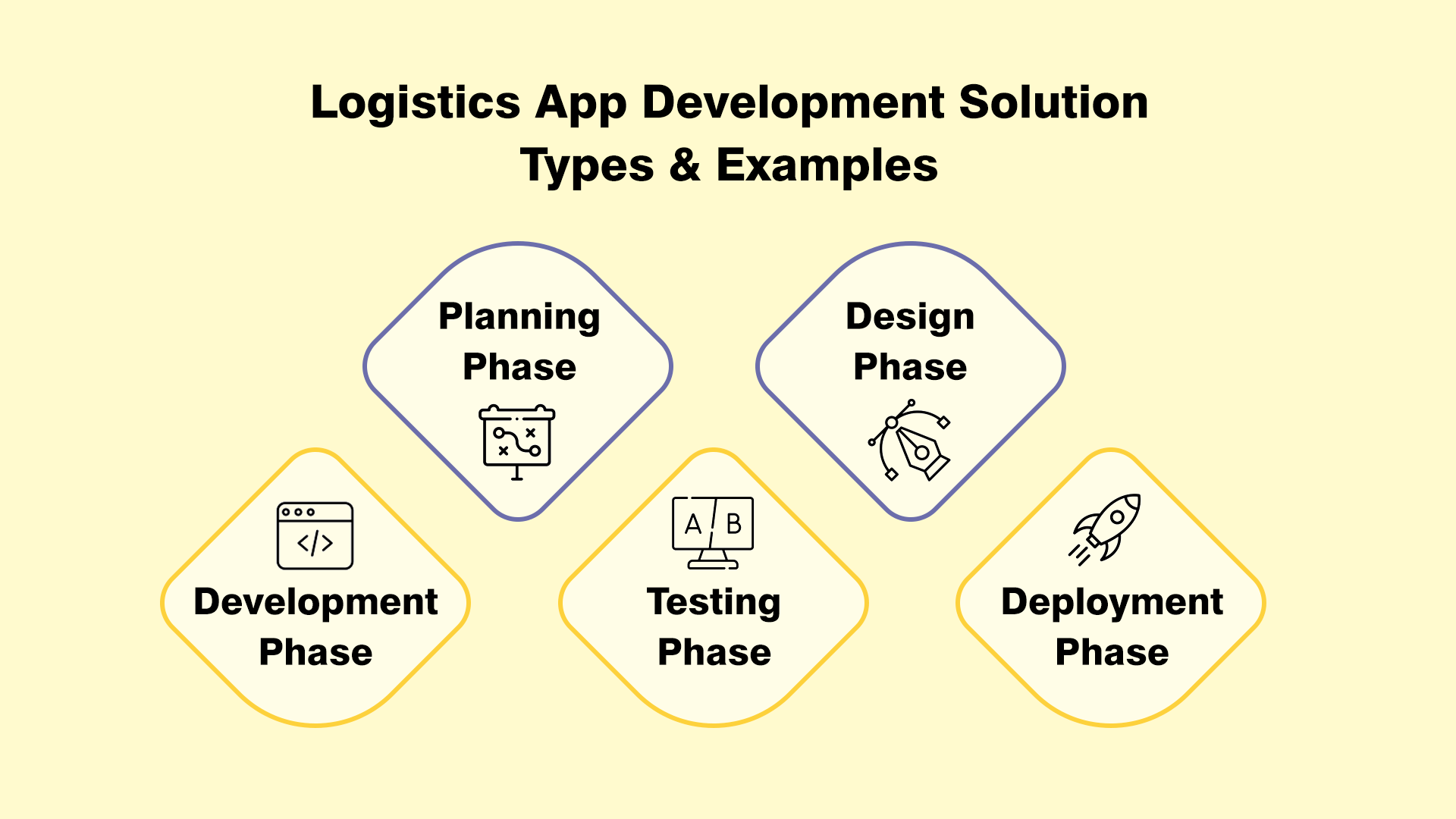
The process of the logistics mobile app development should be carefully planned as well. We will lay out the step by step procedure incorporating the stages of planning, design, development, testing and deployment with different considerations in each one for a proper establishment.
Planning Phase
In this developmental stage, imagine the success of your logistics app by providing a sound base.
- Define Objectives: In other words, specify the objectives irrespective of whether they are for better route optimization, efficient warehouse management or improved customer interaction.
- Identify Target Audience: Know your audience - consumers craving transparency, dispatchers yearning for streamlined operations.
- Market Research: Develop industry trends and competitor analysis with an aim of positioning your app in the market.
- Feature Prioritization: Determine the features to include carefully, by both weighing user needs demands in the market against technological feasibility.
Design Phase
First, your logistic app will be user-friendly and attractive.
- User Experience (UX) Design: Design an interface that makes users’ long and complicated logistics processes easier to use.
- Wireframing: Interestingly, imagine the flow of your app and ensure that it follows a reasonable path for your audience.
- Prototype Development: Build interactive prototypes in order to substantiate the concepts of design and receive valuable comments from the users.
- Branding and Visual Elements: Build a strong visual identity, creating the feeling of loyalty and popularity.
Development Phase
Now is the time to animate your logistics app with the appropriate technologies and a powerful back - end.
- Technology Stack Selection: Pick a stack that matches your scalability demand and cross-platform compatibility criteria.
- Backend Development: Create a robust back-end to process data, authentication, and smooth integration.
- Frontend Development: Materialize your design with frameworks like React Native or Flutter.
- API Development: Ensure seamless communication between frontend and backend elements.
- Database Integration: Choose a database that fits your data storage and retrieval requirements.
Testing Phase
Before the big launch, make sure your logistics app passes the test of functionality, performance and security.
- Functional Testing: Validate that all the features operate as required, satisfying user requirements.
- Performance Testing: Measure the speed, reaction time and possible bottlenecks in different conditions.
- Security Testing: Protect sensitive data with rigorous security audits.
- Usability Testing: Measure user-friendliness to improve the experience as a whole.
- Compatibility Testing: See to it that your app is compatible with different devices and platforms.
Deployment Phase
It is time to share your logistics app with the globe. But first, a strategic rollout.
- Beta Testing: Publish a beta release to gain real-world feedback from users.
- App Store Submission: Follow the guidelines and requirements in the app store for an effortless submission.
- Server Deployment: Make sure your backend is scalable and securely deployed.
- Continuous Monitoring: Monitor post-launch performance and user feedback.
Keep in mind that the logistics app development process involves continuous improvement. Collect the feedback of users, keep up to date with what is happening and be ready to change. Whether you are the inventor of this app or looking for a competent development partner, such a complete roadmap allows you to compete on equal terms in the developing logistics mobile application market. The trip is yours - make it outstanding!
How Much Does it Cost to Build a Logistics App?
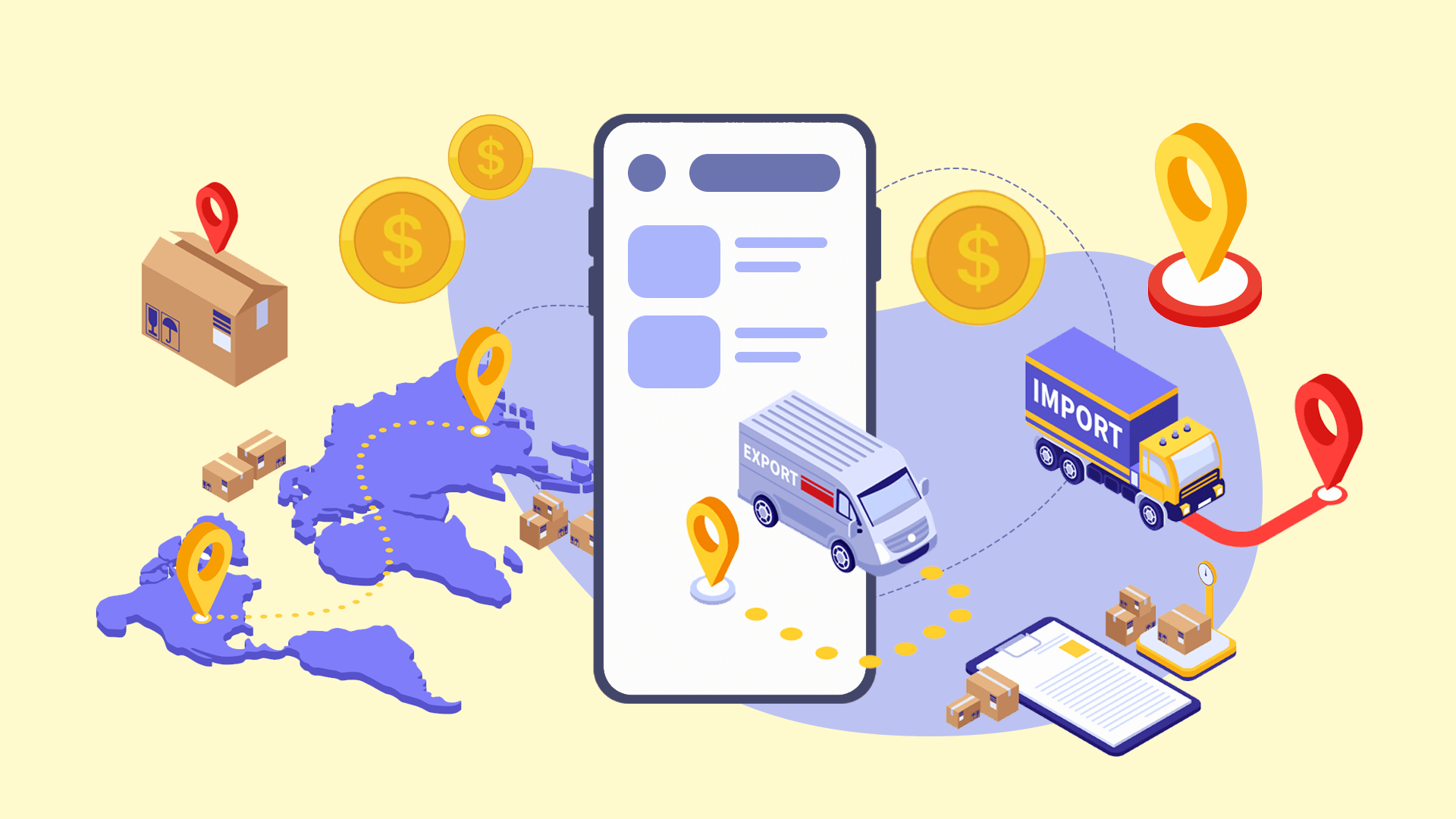
Launching an expedition to construct a logistics app entails weighing different aspects that determine the general cost. Let’s decode the components and provide a simplified breakdown of estimated costs in tabular form.
Factors Influencing Costs
- Complexity of Features - The greater the level of sophistication in features, such as real-time tracking, route optimization and data analytics is to be developed the price cost rises.
- Platform Choice (iOS, Android, Cross - Platform) - The choice of developing for both iOS and Android platforms or going to cross-platform frameworks like React Native/Flutter affects the overall cost.
- User Interfaces (Customer, Driver, Dispatcher) - Creating customized user-friendly interfaces for customers, drivers and dispatchers increases costs as they are separate entities.
- Integration with External Systems - Seamless integration with other systems like ERP or CRM software has an effect on cost depending upon the complexity of the integration.
- Security Measures - The implementation of powerful security options such as data encryption, secure authentication procedures, and compliance to the information protection standards together with adds value towards the cost.
- Scalability Requirements - Anticipating the future development and incorporation of scalable app architecture may result in more costs.
Estimated Cost Breakdown
- Planning and Research - The process of in-depth market research, competitor analysis as well as strategic planning is significantly important with costsing between $5,000 and $10,000.
- Design and Prototyping - usually, designing visually attractive designs or working out prototypes covers the costs somewhere between $10,000 to $20,000.
- Frontend and Backend Development - The heart app development, front end, as well as back-end might be $40,000 to $80,000 recognizing the features advancedness.
- Integration and Testing - Making sure that every part of a system works as it should be and to evaluate its functionality may cost from $15,000 to $30,000.
- Deployment and Launch - The cost of launching the app on iOS app store; Google Play, Windows mobile as well deploying servers is estimated to range from $5,000 and $10,000.
- Post-Launch Maintenance - Plan 10%-20% of development costs should be allocated for ensuring maintenance and periodical updates.
The cost of building a logistics app ranges up to $50,000 for an original and fully functional platform. The most important aspect to consider when engaging a development firm is that the partnership should be trustworthy, goals need to be determined and lastly; the development plan must be in line with your financial resources and vision. Remember that identifying crucial functionalities, paying attention to the app’s future scalability leads to a logical pricing and success of the logistics app development process.
Total Cost Breakdown for Different Levels of Logistics Apps
Depending on requirements, logistics app development has varying levels of complexity. Let’s get to the estimated total costs of creating a Simple App, Moderate App, and an Advanced & Complex App.
Simple App
Elementary functions associated with the Simple Logistics App may include placement of orders, monitoring their movement and elementary inventory management.
| Development Stage | Estimated Cost Range |
|---|---|
| Planning and Research | $3,000 - $7,000 |
| Design and Prototyping | $5,000 - $10,000 |
| Frontend and Backend Development | $15,000 - $30,000 |
| Integration and Testing | $7,000 - $15,000 |
| Deployment and Launch | $3,000 - $7,000 |
| Post-Launch Maintenance | 10-15% of the Development Cost |
Total Estimated Cost for a Simple App: $33,000 - $69,000
Moderate App
A Moderate Logistics App is a middle solution between necessary functions and other optional features like improved tracking, user accounts, and advanced inventory management.
| Development Stage | Estimated Cost Range |
|---|---|
| Planning and Research | $5,000 - $10,000 |
| Design and Prototyping | $10,000 - $20,000 |
| Frontend and Backend Development | $30,000 - $60,000 |
| Integration and Testing | $15,000 - $30,000 |
| Deployment and Launch | $5,000 - $10,000 |
| Post-Launch Maintenance | 15-20% of the Development Cost |
Total Estimated Cost for a Moderate App: $65,000 - $130,000
Advanced & Complex App
The characteristics that an Advanced & Complex Logistics App should have are modern features such as real-time analytics, route optimization, and detailed user roles for customers, drivers, and dispatchers.
| Development Stage | Estimated Cost Range |
|---|---|
| Planning and Research | $7,000 - $15,000 |
| Design and Prototyping | $15,000 - $30,000 |
| Frontend and Backend Development | $50,000 - $100,000 |
| Integration and Testing | $25,000 - $50,000 |
| Deployment and Launch | $7,000 - $15,000 |
| Post-Launch Maintenance | 20-25% of the Development Cost |
Total Estimated Cost for an Advanced & Complex App: $104,000 - $215,000
These projected figures can give you an idea of how much planning and budgeting for your logistics app development project would cost. You should carefully consider the features and complexity of your app to match it with your business goals and budget restrictions.
Conclusion
Are you ready to disrupt your logistics operations with a bespoke app? Addevice is your reliable partner in the implementation of logistics hopes. We specialize in meticulous planning and design, which is user-friendly and cutting edge technology for a smooth transition from ideas to production.
If you would like to find out if it is possible to develop a logistics app based on your particular needs, contact us at Addevice. Together, let’s embark on this journey of transformation where innovation meets efficiency. Contact us for the conversation that might reshape your logistics world. Your app is waiting - let’s create a masterpiece.
Discover the Costs of Crafting Your Custom Logistics App
Dive into the intricacies of logistics app development costs. From planning to deployment, we unveil the factors influencing your project's budget.
Explore:
✅ Cost breakdown for various features
✅ Strategies to optimize expenses
✅ Real-world case studies
Table of contents
FAQ
Some essential capabilities for an app to support logistics processes are real-time tracking, route optimization, inventory management facilities,, intuitive interfaces for drivers and customers alongside simplicity of integration with the third party systems coupled with tight security measures.
The duration of development mainly depends on the degree of an app’s complexity. A basic app can take a few months, while development of an even more complicated application may require half a year to one year or longer. Here it is critically important to take into account the planning stage, design stage, development phase, testing processes and roll out.
Features complexity, platform selection (iOS, Android, cross-platform), user interfaces, integration with third-party systems and security measures impact the price. The breakdown of costs is provided in the article.
Yes, you can build an app for logistics for both iOS and Android platforms by using cross-platform frameworks such as React Native or Flutter. This method can reduce development time and costs.
After launching, maintenance is important in solving any problems that may occur during app use, updating the application and maintaining its safe and updated state with new technologies. It also enables constant enhancements through feedback from the users as well as variation of industry trends.
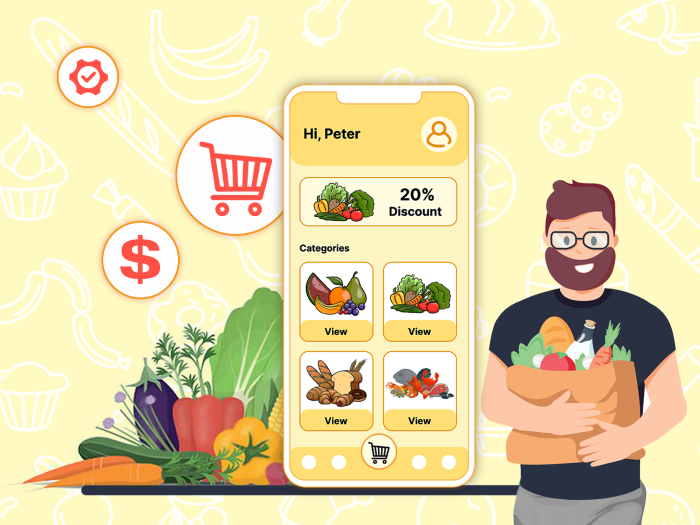 Grocery Delivery App Development: Tips, Cost & Steps
Grocery Delivery App Development: Tips, Cost & Steps
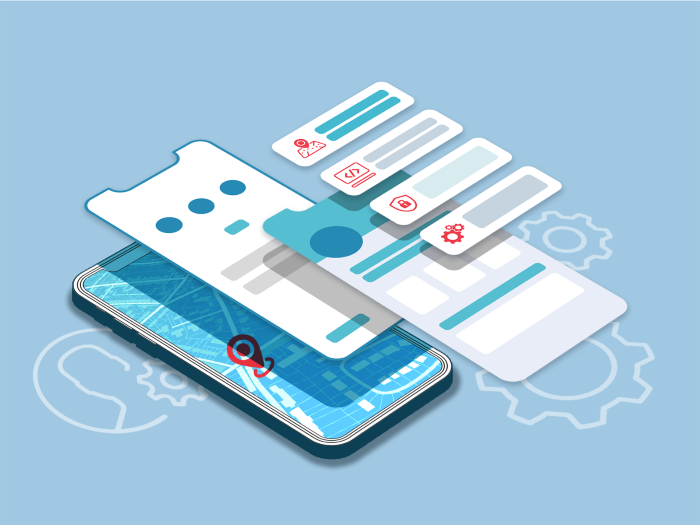 Must-Have Uber App Features: Building a Ridesharing App
Must-Have Uber App Features: Building a Ridesharing App
 How to Make an App Like Uber: Features and Tech Details
How to Make an App Like Uber: Features and Tech Details